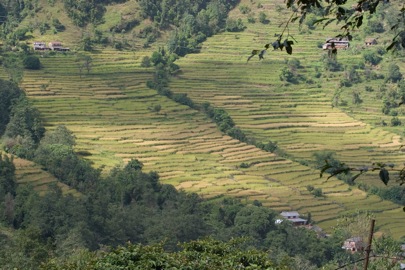- Songs raise awareness about aquatic invasive species. Jeremy says: Kill me now.
- Long, long post about climate change in Africa. Part 2 “coming soon”.
- Yemen prepares for climate change. Need a “strategy for the promotion of rain-fed agriculture”.
- Bananas from Iceland … Jeremy says: I don’t get it.
- New Agriculturist focuses on natural fibres.
Modern rice varieties (can sometimes) increase genetic diversity
![]() People say that introducing high-yielding crop varieties threatens agricultural biodiversity. Farmers adopt the modern varieties and abandon their traditional varieties, so that the overall genetic diversity falls as a result. They’re right, but not every time. A new paper published online in Field Crops Research ((Steele, K., Gyawali, S., Joshi, K., Shrestha, P., Sthapit, B., & Witcombe, J. (2009). Has the introduction of modern rice varieties changed rice genetic diversity in a high-altitude region of Nepal? Field Crops Research DOI: 10.1016/j.fcr.2009.04.002)) shows that genetic erosion need not be the unintended consequence of high-yielding varieties, especially if the modern varieties count farmer varieties among their parents.
People say that introducing high-yielding crop varieties threatens agricultural biodiversity. Farmers adopt the modern varieties and abandon their traditional varieties, so that the overall genetic diversity falls as a result. They’re right, but not every time. A new paper published online in Field Crops Research ((Steele, K., Gyawali, S., Joshi, K., Shrestha, P., Sthapit, B., & Witcombe, J. (2009). Has the introduction of modern rice varieties changed rice genetic diversity in a high-altitude region of Nepal? Field Crops Research DOI: 10.1016/j.fcr.2009.04.002)) shows that genetic erosion need not be the unintended consequence of high-yielding varieties, especially if the modern varieties count farmer varieties among their parents.
In the early 1990s, while a PhD student at Bangor University in the UK, our friend Bhuwon Sthapit, now a senior scientist at Bioversity International, was instrumental in breeding three new varieties of rice suitable for upland rice farms in Nepal. This was no ordinary breeding programme, however. Sthapit worked closely with farmers, who both set the goals of the breeding programme and participated in the selection of the final varieties from the many crosses. The varieties were selected from crosses of Chhomrong Dhan, a local landrace well adapted to the cold conditions of high-altitude rice farms in Nepal, with Fuji 102 and IR36, more productive material from international breeding programmes.

Farmers selected three lines: Machhapuchhre-3 (M3), Machhapuchhre-9 (M9, which is similar to M3 but with lower cold tolerance) and Lumle-2 (L2, like M3 with better grain quality and easier threshing). Only M3 was officially released, but M9 and L2 have been adopted widely thanks to informal seed exchanges among farmers. By 2004 about 60% of the land in the study villages was sown to one of the three COB (client-oriented breeding) varieties, while traditional varieties occupied the remaining 40%. In adopting the COB varieties, many farmers had dropped traditional landraces, but there was no clear pattern to which landraces were dropped in which villages. The variety dropped most commonly was Chhomrong Dhan, one parent of all three COB varieties.
To assess genetic diversity, Sthapit and an international team of the researchers from Bangor and Nepal analyzed DNA from the three COB varieties, a random selection of landraces and a control group of modern varieties. Overall, genetic diversity was greatest in the landraces, and least in the COB varieties. However, there was no loss of genetic diversity across the district as a whole, at least as long as the three COB varieties were adopted on less than about 65% of the land. Indeed, because the high-yielding parental varieties contribute alleles not previously known in the area, there is an increase in diversity as the COB varieties are adopted .
Another crucial result is that although some farmers grow COB varieties on 100% of their land, nevertheless, at least 11 diverse landraces survived on some 40% of the land. These landraces clearly meet needs not fulfilled by the COB varieties. For example, although the most commonly dropped variety was Chhomrong Dhan, farmers in the Gurung community continued to grow that variety.
“It is the preferred rice for preparation of the dish Madeko Bhat used during funerals and other ritual and social ceremonies,” Sthapit told us.
“The conclusion is clear,” Sthapit added. “Participatory breeding and client-oriented breeding programmes should choose locally adapted varieties as parents for breeding. It ensures that landrace genes are conserved and increases the likelihood that the breeding programme will succeed.”
Diversity on air
I’ve been listening to a radio programme about diversity in action. Called The Evolution Boomerang, from Soundprint, it examines three cases where diversity is important to agriculture and the environment. There’s a segment on GMO cotton and insect resistance, a segment on the need for genetic diversity at salmon hatcheries, and a segment on selecting bacteria to degrade a chemical that had never existed on Earth before humans manufactured it.
All good stuff, if you have half an hour to spare. You will need Real Player to listen.
Happy Birthday Kew

How many botanic gardens get such vast quantities of Google love? Or a birthday visit from the Queen of England? Kudos to Kew.
A new use for tubers
A sharp knife is an essential element in the preparation of many vegetables, a fact as true 2 million years ago as it is today. Results from the recent meeting of the Paleoanthropology Society, reported in Science, indicate that the people who occupied the site of Kanjera South in Kenya carried stones that held an edge better from at least 13 kilometres away. Thomas Plummer of Queens College in New York and David Braun of the University of Cape Town found that a third of the stone tools at Kanjera came from elsewhere, and that these stones made longer-lasting knives than local material.
What were they using the knives for? To butcher animals, obviously, but also to cut grass and to process wild tubers. Cristina Lemorini of La Sapienza university here in Rome showed that the pattern of wear on the ancient tools matched the wear on modern stone tools used by the Hadza people of Tanzania to process plant material. In particular, using the stone knives to cut the underground storage tubers of wild plants left a pattern of grooves and scratches that was identical on modern and two-million year old stones.
Why tubers? There have been lots of theories about the role of plant tubers in the evolution of humanity, most of which hinge on the energy to be obtained from tubers, especially when times are hard. Margaret Schoeninger, of the University of California, San Diego, floated an intriguing new idea at the meeting. She noted that most of the tubers provide scant energy, and that modern Hadza chew on slices of tuber but don’t swallow the fibrous quid. Measurements show that panjuko (Ipomoea transvaalensis) and makaritako ((Would you believe not a single instance in Google, apart from a reference to a 2001 paper by Schoeninger? At least until after today. Insert obligatory rant about common names without binomials here. And if you have a binomial, please share it, for those who come after us)) can be up to 80% water. Schoeninger thinks that early humans used the tubers as portable canteens.
That might raise the question: why weren’t they domesticated? That’s an unanswerable hypothetical, but the simple answer might be that there was just no need to.